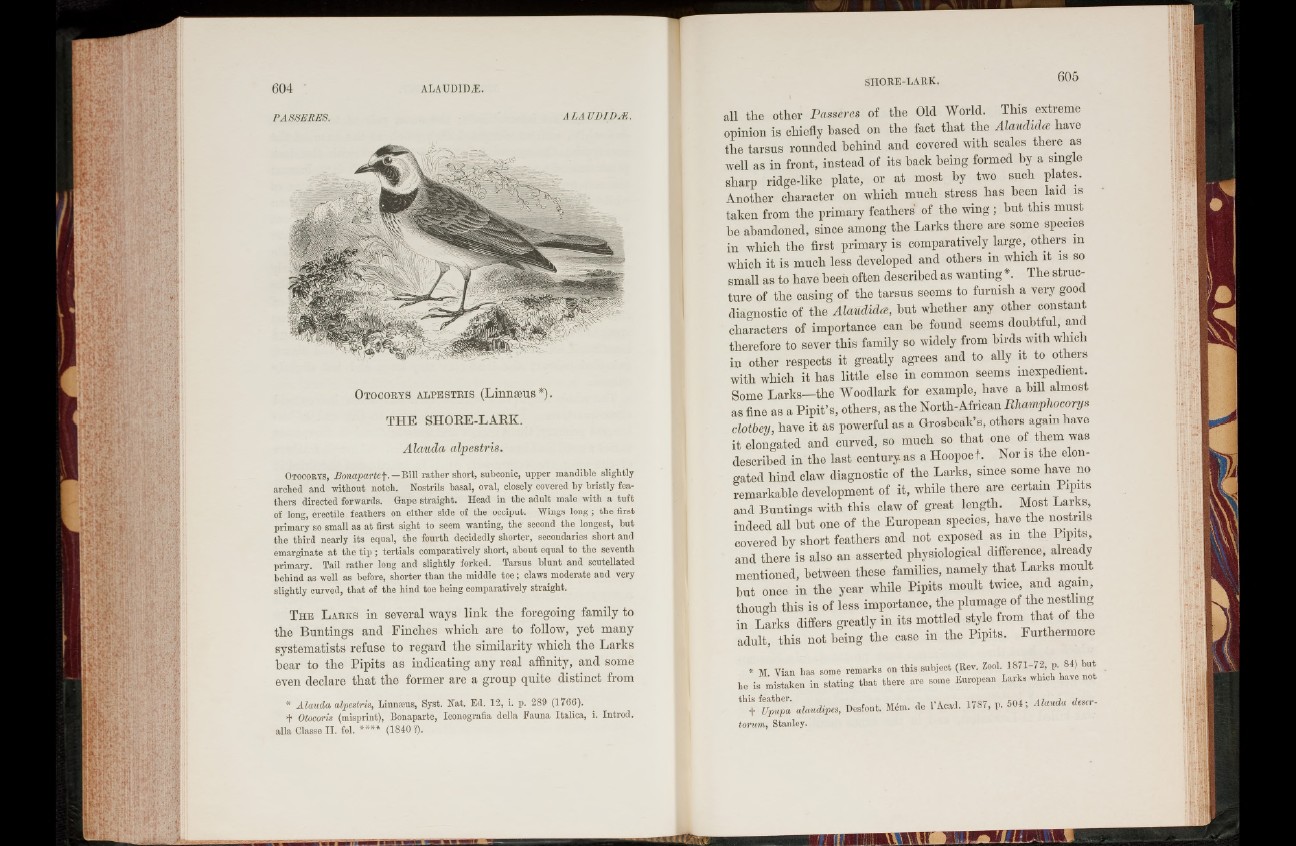
PASSERES. A L AU D IO A!.
O to co ry s a l p e s t r is (Linnaeus*).
THE SHORE-LARK.
Alauda alpestris.
Otocorys, Bonapartef .— Bill rather short, subconic, upper mandible slightly
arched and without notch. Nostrils basal, oval, closely covered by bristly feathers
directed forwards. Grape straight. Head in the adult male with a tuft
of long, erectile feathers on either side of the occiput. Wings long ; the first
primary so small as a t first sight to seem wanting, the second the longest, but
the third nearly its equal, the fourth decidedly shorter, secondaries short and
emarginate a t the tip ; tertials comparatively short, about equal to the seventh
primary. Tail rather long and slightly forked. Tarsus blunt and scutellated
behind as well as before, shorter than the middle to e ; claws moderate and very
slightly curved, that of the hind toe being comparatively straight.
T h e L a rk s in several ways link tlie foregoing family to
the Buntings and Finches which are to follow, yet many
systematists refuse to regard the similarity which the Larks
hear to the Pipits as indicating any real affinity, and some
even declare that the former are a group quite distinct from
* Alauda alpestris, Linnseus, Syst. Nat. Ed. 12, i. p. 289 (1766).
1* Otocoris (misprint), Bonaparte, Iconografia della Fauna Italica, i. Introd.
alia Classe II. fol. **** (1840 ?).
all the other Passeres of the Old World. This extreme
opinion is chiefly based on the fact that the Alaudidce have
the tarsus rounded behind and covered with scales there as
well as in front, instead of its back being formed by a single
sharp ridge-like plate, or at most by two such plates.
Another character on which much stress has been laid is
taken from the primary feathers' of the wing; but this must
be abandoned, since among the Larks there are some species
in which the first primary is comparatively large, others in
which it is much less developed and others in which it is so
small as to have been often described as wanting *. The structure
of the casing of the tarsus seems to furnish a very good
diagnostic of the Alaudidce, but whether any other constant
characters of importance can be found seems doubtful, and
therefore to sever this family so widely from birds with which
in other respects it greatly agrees and to ally it to others
with which it has little else in common seems inexpedient.
Some Larks—the Woodlark for example, have a bill almost
as fine as a Pipit’s, others, as the North-African Ehamphocorys
clotbey, have it as powerful as a Grosbeak’s, others again have
it elongated and curved, so much so that one of them was
described in the last century as a Hoopoe+. Nor is the elongated
hind claw diagnostic of the Larks, since some have no
remarkable development of it, while there are certain Pipi s
and Buntings with this claw of great length. Most Larks,
indeed all but one of the European species, have the nostrils
covered by short feathers and not exposed as m the lip its ,
and there is also an asserted physiological difference already
mentioned, between these families, namely that Larks moult
but once in the year while Pipits moult twice and again,
though this is of less importance, the plumage of the nestling
in Larks differs greatly in its mottled style from that of the
adult, this not being the case in the Pipits. Furthermore
* M. Vian lias some remarks on this subject (Rev. Zool. 1871-72, p. 84) but
he is mistaken in stating that there are some European Larks winch have no
tUt “ « D- font- Mim- de rACad' 1787’ P' 5°4; AlCUlda dmr~
torum, Stanley.